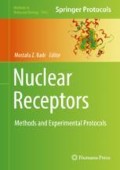Abstract
This chapter describes a technique that can be used to isolate adipose tissue macrophages (ATMs) from the visceral white adipose tissue. Nevertheless, this technique can also be used to isolate ATMs from subcutaneous white adipose tissue and brown adipose tissue from mouse, human subcutaneous fat depot, and also from the fat body of the toad Xenopus. We detail the flow-cytometric gating strategy that has been developed to identify ATM population, and we describe the isolation of RNA from this population and its use for gene expression profiling. Finally, we describe in vitro culture of ATMs for downstream applications.
Access this chapter
Tax calculation will be finalised at checkout
Purchases are for personal use only
References
Ginhoux F, Schultze JL, Murray PJ et al (2015) New insights into the multidimensional concept of macrophage ontogeny, activation and function. Nat Immunol 17:34
Epelman S, Lavine Kory J, Randolph Gwendalyn J (2014) Origin and functions of tissue macrophages. Immunity 41(1):21–35
Hausman DB, Park HJ, Hausman GJ (2008) Isolation and culture of preadipocytes from rodent white adipose tissue. In: Yang K (ed) Adipose tissue protocols. Humana Press, Totowa, NJ, pp 201–219
Boutens L, Stienstra R (2016) Adipose tissue macrophages: going off track during obesity. Diabetologia 59(5):879–894
Waqas SFH, Hoang AC, Lin Y-T et al (2017) Neuropeptide FF increases M2 activation and self-renewal of adipose tissue macrophages. J Clin Invest 127(7):2842–2854
Aron-Wisnewsky J, Tordjman J, Poitou C et al (2009) Human adipose tissue macrophages: m1 and m2 cell surface markers in subcutaneous and omental depots and after weight loss. J Clin Endocrinol Metab 94(11):4619–4623
Fjeldborg K, Pedersen SB, Møller HJ et al (2014) Human adipose tissue macrophages are enhanced but changed to an anti-inflammatory profile in obesity. J Immunol Res 2014:10
Ampem G, Azegrouz H, Bacsadi Á et al (2016) Adipose tissue macrophages in non-rodent mammals: a comparative study. Cell Tissue Res 363(2):461–478
Waqas SFH, Noble A, Hoang AC et al (2017) Adipose tissue macrophages develop from bone marrow–independent progenitors in Xenopus laevis and mouse. J Leukoc Biol 102(3):845–855
Grant RW, Dixit VD (2015) Adipose tissue as an immunological organ. Obesity 23(3):512–518
Osborn O, Olefsky JM (2012) The cellular and signaling networks linking the immune system and metabolism in disease. Nat Med 18:363
Adan A, Alizada G, Kiraz Y et al (2017) Flow cytometry: basic principles and applications. Crit Rev Biotechnol 37(2):163–176
Mandy FF, Bergeron M, Minkus T (1995) Principles of flow cytometry. Transfus Sci 16(4):303–314
Roederer M (2001) Spectral compensation for flow cytometry: visualization artifacts, limitations, and caveats. Cytometry 45(3):194–205
Union OJotE Directive 2010/63/EU of the European Parliament and of the Council of 22 September 2010 on the protection of animals used for scientific purposes Text with EEA relevance. 20.10.2010 [cited 2018; 29.04.2018]; Available from http://eur-lex.europa.eu/eli/dir/2010/63/oj
Scientific T Convert between times gravity (×g) and centrifuge rotor speed (RPM) 2009 [cited 2018; 29.04.2018]; Available from https://tools.thermofisher.com/content/sfs/brochures/TR0040-Centrifuge-speed.pdf
Acknowledgments
The work in the authors’ laboratory is supported by a German Research Fund (DFG) grant and by the European Foundation for the Study of Diabetes (EFSD). Scopus author identifiers of the authors are 56764443800 (G.A.) and 7801656864 (T.R.).
Author information
Authors and Affiliations
Corresponding author
Editor information
Editors and Affiliations
Rights and permissions
Copyright information
© 2019 Springer Science+Business Media, LLC, part of Springer Nature
About this protocol
Cite this protocol
Ampem, G., Röszer, T. (2019). Isolation and Characterization of Adipose Tissue Macrophages. In: Badr, M. (eds) Nuclear Receptors. Methods in Molecular Biology, vol 1966. Humana, New York, NY. https://doi.org/10.1007/978-1-4939-9195-2_18
Download citation
DOI: https://doi.org/10.1007/978-1-4939-9195-2_18
Published:
Publisher Name: Humana, New York, NY
Print ISBN: 978-1-4939-9194-5
Online ISBN: 978-1-4939-9195-2
eBook Packages: Springer Protocols

